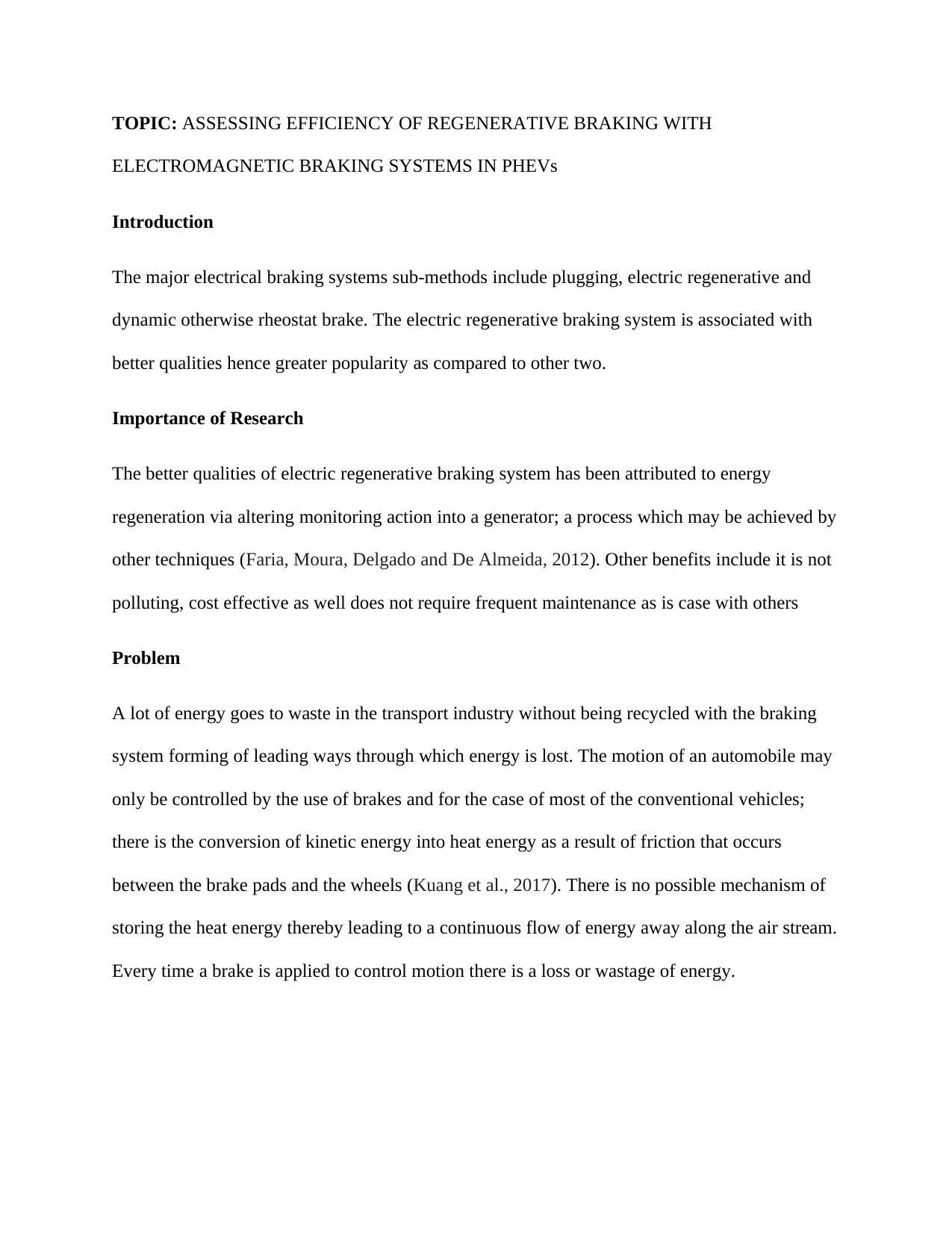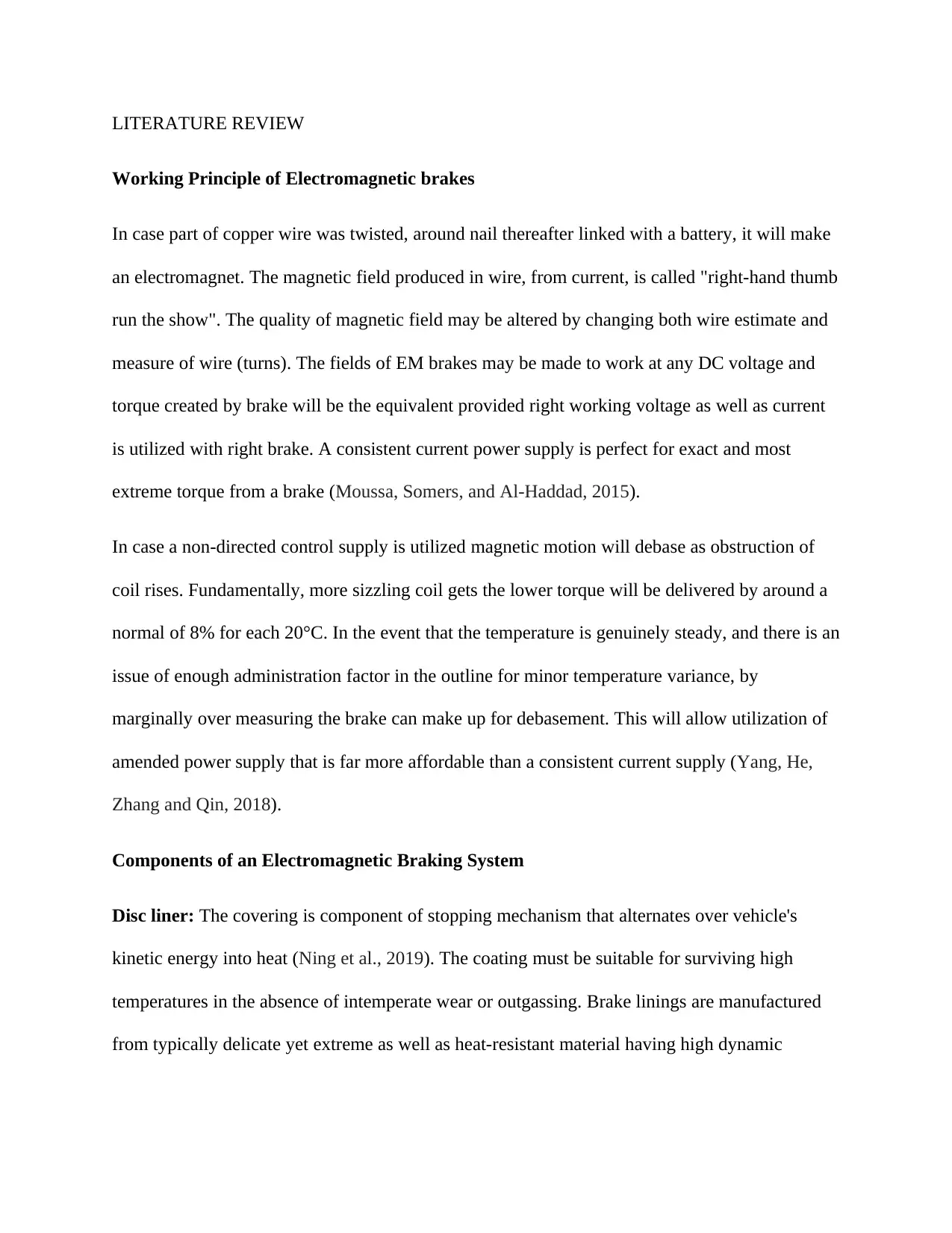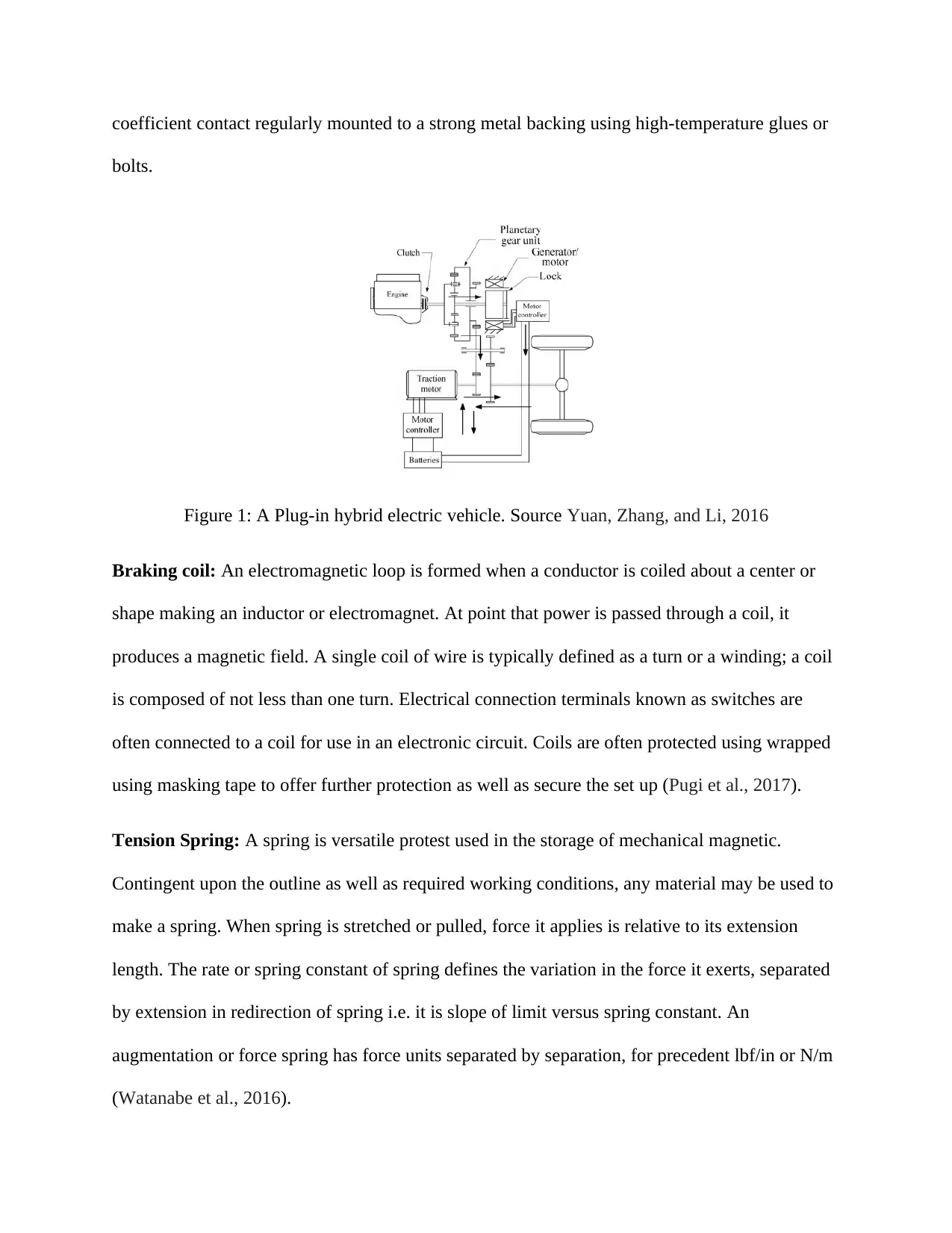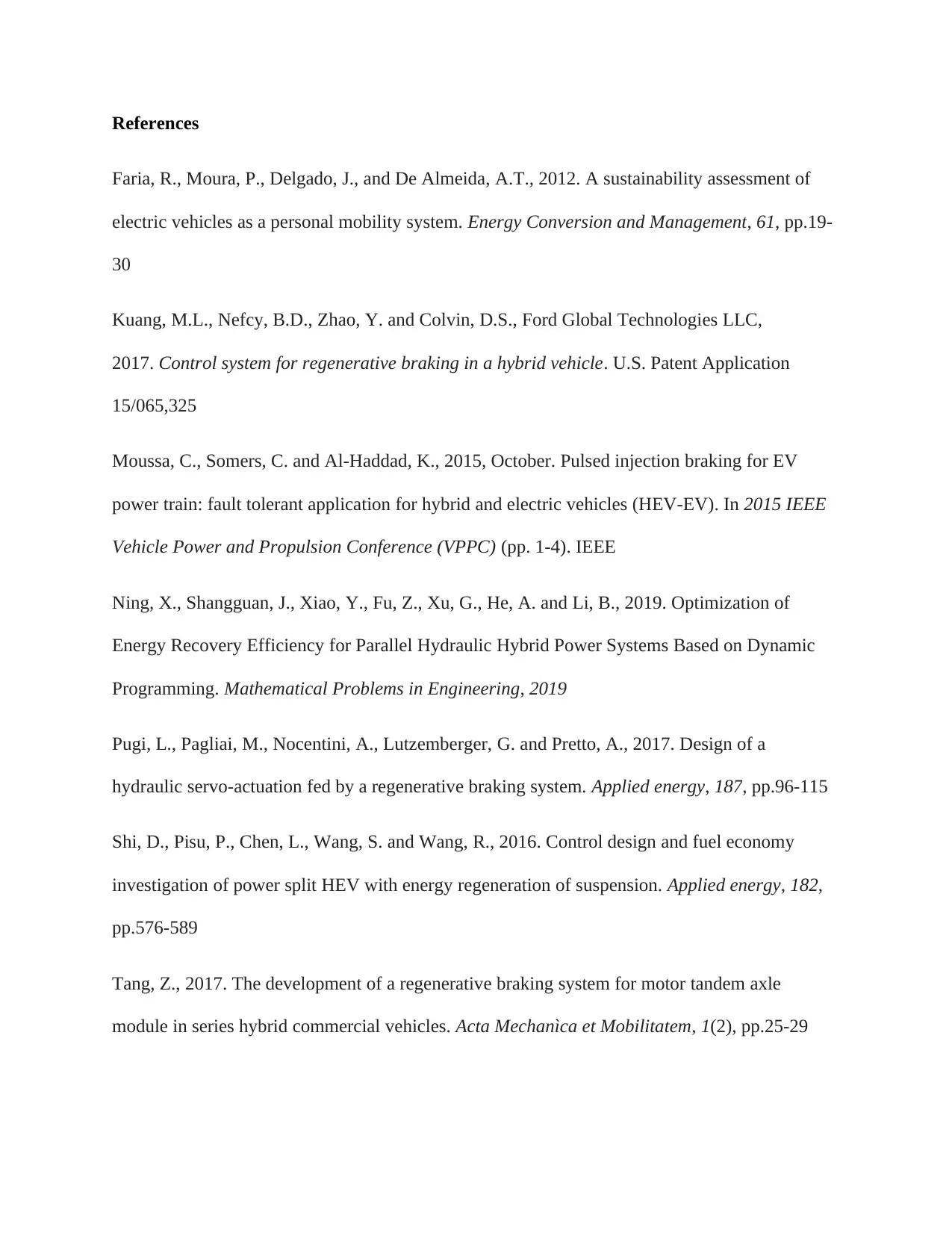Research Report: Efficiency Assessment of Regenerative Braking Systems
VerifiedAdded on 2023/01/16
|9
|1871
|26
Report
AI Summary
This research report investigates the efficiency of regenerative braking systems, specifically focusing on the integration of electromagnetic braking in Plug-in Hybrid Electric Vehicles (PHEVs). The report begins with an introduction highlighting the importance of energy regeneration in the transport industry and the inefficiencies of conventional braking systems. It then reviews the working principles and components of electromagnetic braking systems, including disc liners, braking coils, tension springs, batteries, alloy wheels, and electromagnets. The literature review emphasizes the potential benefits of electromagnetic brakes over conventional systems. The report concludes by noting the lack of comprehensive comparative studies on the efficiency of electromagnetic braking systems, setting the stage for future research. The report also includes references to relevant research papers.

RESEARCH METHODOLOGY
By Name
Course
Instructor
Institution
Location
Date
By Name
Course
Instructor
Institution
Location
Date
Paraphrase This Document
Need a fresh take? Get an instant paraphrase of this document with our AI Paraphraser

TOPIC: ASSESSING EFFICIENCY OF REGENERATIVE BRAKING WITH
ELECTROMAGNETIC BRAKING SYSTEMS IN PHEVs
Introduction
The major electrical braking systems sub-methods include plugging, electric regenerative and
dynamic otherwise rheostat brake. The electric regenerative braking system is associated with
better qualities hence greater popularity as compared to other two.
Importance of Research
The better qualities of electric regenerative braking system has been attributed to energy
regeneration via altering monitoring action into a generator; a process which may be achieved by
other techniques (Faria, Moura, Delgado and De Almeida, 2012). Other benefits include it is not
polluting, cost effective as well does not require frequent maintenance as is case with others
Problem
A lot of energy goes to waste in the transport industry without being recycled with the braking
system forming of leading ways through which energy is lost. The motion of an automobile may
only be controlled by the use of brakes and for the case of most of the conventional vehicles;
there is the conversion of kinetic energy into heat energy as a result of friction that occurs
between the brake pads and the wheels (Kuang et al., 2017). There is no possible mechanism of
storing the heat energy thereby leading to a continuous flow of energy away along the air stream.
Every time a brake is applied to control motion there is a loss or wastage of energy.
ELECTROMAGNETIC BRAKING SYSTEMS IN PHEVs
Introduction
The major electrical braking systems sub-methods include plugging, electric regenerative and
dynamic otherwise rheostat brake. The electric regenerative braking system is associated with
better qualities hence greater popularity as compared to other two.
Importance of Research
The better qualities of electric regenerative braking system has been attributed to energy
regeneration via altering monitoring action into a generator; a process which may be achieved by
other techniques (Faria, Moura, Delgado and De Almeida, 2012). Other benefits include it is not
polluting, cost effective as well does not require frequent maintenance as is case with others
Problem
A lot of energy goes to waste in the transport industry without being recycled with the braking
system forming of leading ways through which energy is lost. The motion of an automobile may
only be controlled by the use of brakes and for the case of most of the conventional vehicles;
there is the conversion of kinetic energy into heat energy as a result of friction that occurs
between the brake pads and the wheels (Kuang et al., 2017). There is no possible mechanism of
storing the heat energy thereby leading to a continuous flow of energy away along the air stream.
Every time a brake is applied to control motion there is a loss or wastage of energy.

LITERATURE REVIEW
Working Principle of Electromagnetic brakes
In case part of copper wire was twisted, around nail thereafter linked with a battery, it will make
an electromagnet. The magnetic field produced in wire, from current, is called "right-hand thumb
run the show". The quality of magnetic field may be altered by changing both wire estimate and
measure of wire (turns). The fields of EM brakes may be made to work at any DC voltage and
torque created by brake will be the equivalent provided right working voltage as well as current
is utilized with right brake. A consistent current power supply is perfect for exact and most
extreme torque from a brake (Moussa, Somers, and Al-Haddad, 2015).
In case a non-directed control supply is utilized magnetic motion will debase as obstruction of
coil rises. Fundamentally, more sizzling coil gets the lower torque will be delivered by around a
normal of 8% for each 20°C. In the event that the temperature is genuinely steady, and there is an
issue of enough administration factor in the outline for minor temperature variance, by
marginally over measuring the brake can make up for debasement. This will allow utilization of
amended power supply that is far more affordable than a consistent current supply (Yang, He,
Zhang and Qin, 2018).
Components of an Electromagnetic Braking System
Disc liner: The covering is component of stopping mechanism that alternates over vehicle's
kinetic energy into heat (Ning et al., 2019). The coating must be suitable for surviving high
temperatures in the absence of intemperate wear or outgassing. Brake linings are manufactured
from typically delicate yet extreme as well as heat-resistant material having high dynamic
Working Principle of Electromagnetic brakes
In case part of copper wire was twisted, around nail thereafter linked with a battery, it will make
an electromagnet. The magnetic field produced in wire, from current, is called "right-hand thumb
run the show". The quality of magnetic field may be altered by changing both wire estimate and
measure of wire (turns). The fields of EM brakes may be made to work at any DC voltage and
torque created by brake will be the equivalent provided right working voltage as well as current
is utilized with right brake. A consistent current power supply is perfect for exact and most
extreme torque from a brake (Moussa, Somers, and Al-Haddad, 2015).
In case a non-directed control supply is utilized magnetic motion will debase as obstruction of
coil rises. Fundamentally, more sizzling coil gets the lower torque will be delivered by around a
normal of 8% for each 20°C. In the event that the temperature is genuinely steady, and there is an
issue of enough administration factor in the outline for minor temperature variance, by
marginally over measuring the brake can make up for debasement. This will allow utilization of
amended power supply that is far more affordable than a consistent current supply (Yang, He,
Zhang and Qin, 2018).
Components of an Electromagnetic Braking System
Disc liner: The covering is component of stopping mechanism that alternates over vehicle's
kinetic energy into heat (Ning et al., 2019). The coating must be suitable for surviving high
temperatures in the absence of intemperate wear or outgassing. Brake linings are manufactured
from typically delicate yet extreme as well as heat-resistant material having high dynamic
⊘ This is a preview!⊘
Do you want full access?
Subscribe today to unlock all pages.

Trusted by 1+ million students worldwide

coefficient contact regularly mounted to a strong metal backing using high-temperature glues or
bolts.
Figure 1: A Plug-in hybrid electric vehicle. Source Yuan, Zhang, and Li, 2016
Braking coil: An electromagnetic loop is formed when a conductor is coiled about a center or
shape making an inductor or electromagnet. At point that power is passed through a coil, it
produces a magnetic field. A single coil of wire is typically defined as a turn or a winding; a coil
is composed of not less than one turn. Electrical connection terminals known as switches are
often connected to a coil for use in an electronic circuit. Coils are often protected using wrapped
using masking tape to offer further protection as well as secure the set up (Pugi et al., 2017).
Tension Spring: A spring is versatile protest used in the storage of mechanical magnetic.
Contingent upon the outline as well as required working conditions, any material may be used to
make a spring. When spring is stretched or pulled, force it applies is relative to its extension
length. The rate or spring constant of spring defines the variation in the force it exerts, separated
by extension in redirection of spring i.e. it is slope of limit versus spring constant. An
augmentation or force spring has force units separated by separation, for precedent lbf/in or N/m
(Watanabe et al., 2016).
bolts.
Figure 1: A Plug-in hybrid electric vehicle. Source Yuan, Zhang, and Li, 2016
Braking coil: An electromagnetic loop is formed when a conductor is coiled about a center or
shape making an inductor or electromagnet. At point that power is passed through a coil, it
produces a magnetic field. A single coil of wire is typically defined as a turn or a winding; a coil
is composed of not less than one turn. Electrical connection terminals known as switches are
often connected to a coil for use in an electronic circuit. Coils are often protected using wrapped
using masking tape to offer further protection as well as secure the set up (Pugi et al., 2017).
Tension Spring: A spring is versatile protest used in the storage of mechanical magnetic.
Contingent upon the outline as well as required working conditions, any material may be used to
make a spring. When spring is stretched or pulled, force it applies is relative to its extension
length. The rate or spring constant of spring defines the variation in the force it exerts, separated
by extension in redirection of spring i.e. it is slope of limit versus spring constant. An
augmentation or force spring has force units separated by separation, for precedent lbf/in or N/m
(Watanabe et al., 2016).
Paraphrase This Document
Need a fresh take? Get an instant paraphrase of this document with our AI Paraphraser

Battery: A battery is device which proselytes mechanical energy often to electrical energy. It is
composed of numerous voltaic cells; every voltaic cell made up of two half cells clinked in series
by conductive electrolyte that contains anions as well as cations (Zhao, Deng, Wu and He, 2017).
One half-cell is composed of electrolyte as well as terminal where anions move that is anode or
negative cathode; other half-cell incorporates electrolyte as well as terminal where cations
relocate, i.e., cathode or positive anode. In redox reaction which powers battery, reduce positive
cations at cathode, while negative anions escape at anode (Shi, Pisu, Chen, Wang and Wang,
2016).
Alloy wheels: Alloy wheels have illustrated to be impressively more typical since 2000.
Combination tyres are car tyres that are generated using a composite of aluminum or magnesium
(Zhang et al., 2018). They are commonly lighter for the same quality besides providing
conductivity of electricity alongside enhanced corrective appearance over steel wheels. The
earliest light composite tyres were made of magnesium amalgams. Amalgam tyres have for a
long time been included as level hardware on higher-evaluated wastage or games autos, with
greater length or "choice" compound tyres being alternatives (Tang, 2017).
Electro-magnet: An electromagnet is sort of magnet where magnetic field is delivered by flow
of electric current. Electric current flowing in wire makes a magnetic field around the wire
(Trifa, Brezeanu, and Ceuca, 2018). Suppose magnetic field, in electromagnet wire is wound into
loop having several turns of wire placed close to each other. The magnetic field of a significant
of turns of wire passes via coil focal point, making strong magnetic field. The direction of
magnetic field via a wire loop may be determined by a kind of right-hand run show.
composed of numerous voltaic cells; every voltaic cell made up of two half cells clinked in series
by conductive electrolyte that contains anions as well as cations (Zhao, Deng, Wu and He, 2017).
One half-cell is composed of electrolyte as well as terminal where anions move that is anode or
negative cathode; other half-cell incorporates electrolyte as well as terminal where cations
relocate, i.e., cathode or positive anode. In redox reaction which powers battery, reduce positive
cations at cathode, while negative anions escape at anode (Shi, Pisu, Chen, Wang and Wang,
2016).
Alloy wheels: Alloy wheels have illustrated to be impressively more typical since 2000.
Combination tyres are car tyres that are generated using a composite of aluminum or magnesium
(Zhang et al., 2018). They are commonly lighter for the same quality besides providing
conductivity of electricity alongside enhanced corrective appearance over steel wheels. The
earliest light composite tyres were made of magnesium amalgams. Amalgam tyres have for a
long time been included as level hardware on higher-evaluated wastage or games autos, with
greater length or "choice" compound tyres being alternatives (Tang, 2017).
Electro-magnet: An electromagnet is sort of magnet where magnetic field is delivered by flow
of electric current. Electric current flowing in wire makes a magnetic field around the wire
(Trifa, Brezeanu, and Ceuca, 2018). Suppose magnetic field, in electromagnet wire is wound into
loop having several turns of wire placed close to each other. The magnetic field of a significant
of turns of wire passes via coil focal point, making strong magnetic field. The direction of
magnetic field via a wire loop may be determined by a kind of right-hand run show.

The efficiency of electromagnetic braking systems with regard to rate of energy production as
well as conversion has not been exclusively been explored. A comparative study of efficiency
electromagnetic braking systems and the conventional braking systems is yet to be made
well as conversion has not been exclusively been explored. A comparative study of efficiency
electromagnetic braking systems and the conventional braking systems is yet to be made
⊘ This is a preview!⊘
Do you want full access?
Subscribe today to unlock all pages.

Trusted by 1+ million students worldwide

References
Faria, R., Moura, P., Delgado, J., and De Almeida, A.T., 2012. A sustainability assessment of
electric vehicles as a personal mobility system. Energy Conversion and Management, 61, pp.19-
30
Kuang, M.L., Nefcy, B.D., Zhao, Y. and Colvin, D.S., Ford Global Technologies LLC,
2017. Control system for regenerative braking in a hybrid vehicle. U.S. Patent Application
15/065,325
Moussa, C., Somers, C. and Al-Haddad, K., 2015, October. Pulsed injection braking for EV
power train: fault tolerant application for hybrid and electric vehicles (HEV-EV). In 2015 IEEE
Vehicle Power and Propulsion Conference (VPPC) (pp. 1-4). IEEE
Ning, X., Shangguan, J., Xiao, Y., Fu, Z., Xu, G., He, A. and Li, B., 2019. Optimization of
Energy Recovery Efficiency for Parallel Hydraulic Hybrid Power Systems Based on Dynamic
Programming. Mathematical Problems in Engineering, 2019
Pugi, L., Pagliai, M., Nocentini, A., Lutzemberger, G. and Pretto, A., 2017. Design of a
hydraulic servo-actuation fed by a regenerative braking system. Applied energy, 187, pp.96-115
Shi, D., Pisu, P., Chen, L., Wang, S. and Wang, R., 2016. Control design and fuel economy
investigation of power split HEV with energy regeneration of suspension. Applied energy, 182,
pp.576-589
Tang, Z., 2017. The development of a regenerative braking system for motor tandem axle
module in series hybrid commercial vehicles. Acta Mechanìca et Mobilitatem, 1(2), pp.25-29
Faria, R., Moura, P., Delgado, J., and De Almeida, A.T., 2012. A sustainability assessment of
electric vehicles as a personal mobility system. Energy Conversion and Management, 61, pp.19-
30
Kuang, M.L., Nefcy, B.D., Zhao, Y. and Colvin, D.S., Ford Global Technologies LLC,
2017. Control system for regenerative braking in a hybrid vehicle. U.S. Patent Application
15/065,325
Moussa, C., Somers, C. and Al-Haddad, K., 2015, October. Pulsed injection braking for EV
power train: fault tolerant application for hybrid and electric vehicles (HEV-EV). In 2015 IEEE
Vehicle Power and Propulsion Conference (VPPC) (pp. 1-4). IEEE
Ning, X., Shangguan, J., Xiao, Y., Fu, Z., Xu, G., He, A. and Li, B., 2019. Optimization of
Energy Recovery Efficiency for Parallel Hydraulic Hybrid Power Systems Based on Dynamic
Programming. Mathematical Problems in Engineering, 2019
Pugi, L., Pagliai, M., Nocentini, A., Lutzemberger, G. and Pretto, A., 2017. Design of a
hydraulic servo-actuation fed by a regenerative braking system. Applied energy, 187, pp.96-115
Shi, D., Pisu, P., Chen, L., Wang, S. and Wang, R., 2016. Control design and fuel economy
investigation of power split HEV with energy regeneration of suspension. Applied energy, 182,
pp.576-589
Tang, Z., 2017. The development of a regenerative braking system for motor tandem axle
module in series hybrid commercial vehicles. Acta Mechanìca et Mobilitatem, 1(2), pp.25-29
Paraphrase This Document
Need a fresh take? Get an instant paraphrase of this document with our AI Paraphraser

Trifa, V., Brezeanu, G. and Ceuca, E., 2018, May. Analyzing the Efficiency of the Different
Ways of Recovering Energy from a System Using a PMSM. In 2018 41st International Spring
Seminar on Electronics Technology (ISSE) (pp. 1-4). IEEE
Watanabe, T., Tsuchiya, E., Ebina, M., Osada, Y., Toyama, T. and Murakami, A., 2016. High-
efficiency electromagnetic torque converter for hybrid electric vehicles. SAE International
Journal of Alternative Powertrains, 5(2), pp.228-236
Yang, Y., He, X., Zhang, Y. and Qin, D., 2018. Regenerative braking compensatory control
strategy considering CVT power loss for hybrid electric vehicles. Energies, 11(3), p.497
Yazdanpanah, R. and Mirsalim, M., 2015. Hybrid electromagnetic brakes: design and
performance evaluation. IEEE Transactions on Energy Conversion, 30(1), pp.60-69
Yuan, Y., Zhang, J., Lv, C. and Li, Y., 2016. Design and performance analysis of a novel
regenerative braking system for electrified passenger vehicles. SAE International Journal of
Materials and Manufacturing, 9(3), pp.699-706
Zhang, Z., He, C., Xu, J., Yu, G. and Wang, G., 2018, December. Study on Braking
Characteristics of Regenerative Brake-By-Wire System Based on Mechanical-Electron-
Magnetism Integration for Electric Vehicles. In IOP Conference Series: Materials Science and
Engineering (Vol. 452, No. 4, p. 042164). IOP Publishing
Zhao, Y., Deng, W., Wu, J. and He, R., 2017. Torque control allocation based on constrained
optimization with regenerative braking for electric vehicles. International journal of automotive
technology, 18(4), pp.685-698
Ways of Recovering Energy from a System Using a PMSM. In 2018 41st International Spring
Seminar on Electronics Technology (ISSE) (pp. 1-4). IEEE
Watanabe, T., Tsuchiya, E., Ebina, M., Osada, Y., Toyama, T. and Murakami, A., 2016. High-
efficiency electromagnetic torque converter for hybrid electric vehicles. SAE International
Journal of Alternative Powertrains, 5(2), pp.228-236
Yang, Y., He, X., Zhang, Y. and Qin, D., 2018. Regenerative braking compensatory control
strategy considering CVT power loss for hybrid electric vehicles. Energies, 11(3), p.497
Yazdanpanah, R. and Mirsalim, M., 2015. Hybrid electromagnetic brakes: design and
performance evaluation. IEEE Transactions on Energy Conversion, 30(1), pp.60-69
Yuan, Y., Zhang, J., Lv, C. and Li, Y., 2016. Design and performance analysis of a novel
regenerative braking system for electrified passenger vehicles. SAE International Journal of
Materials and Manufacturing, 9(3), pp.699-706
Zhang, Z., He, C., Xu, J., Yu, G. and Wang, G., 2018, December. Study on Braking
Characteristics of Regenerative Brake-By-Wire System Based on Mechanical-Electron-
Magnetism Integration for Electric Vehicles. In IOP Conference Series: Materials Science and
Engineering (Vol. 452, No. 4, p. 042164). IOP Publishing
Zhao, Y., Deng, W., Wu, J. and He, R., 2017. Torque control allocation based on constrained
optimization with regenerative braking for electric vehicles. International journal of automotive
technology, 18(4), pp.685-698

Zhao, Y., Kuang, M.L. and Liu, Z., Ford Global Technologies LLC, 2018. Optimizing
regenerative braking efficiency in a hybrid vehicle. U.S. Patent Application 15/485,845
regenerative braking efficiency in a hybrid vehicle. U.S. Patent Application 15/485,845
⊘ This is a preview!⊘
Do you want full access?
Subscribe today to unlock all pages.

Trusted by 1+ million students worldwide
1 out of 9
Related Documents
Your All-in-One AI-Powered Toolkit for Academic Success.
+13062052269
info@desklib.com
Available 24*7 on WhatsApp / Email
![[object Object]](/_next/static/media/star-bottom.7253800d.svg)
Unlock your academic potential
Copyright © 2020–2025 A2Z Services. All Rights Reserved. Developed and managed by ZUCOL.





